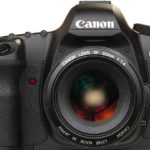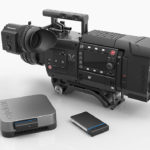
Building the fastest computer in the World
Posted on Jun 29, 2015 by Julian Mitchell
Strongbox technology, a new name in computer supply to the film and TV industries, but what makes them so fast?
Brian Gannon, technical director of Strongbox Technology, is a self-confessed computer geek. At the age of eight when instead of the games console he wanted for Christmas he got his first computer he knew what he wanted to do. Luckily two doors down from him lived a computer programmer, “He gave me some books and I noticed that when I was typing out what was in the books in to the computer that when I made little mistakes weird and wonderful things happened.”
Brian went on to create and publish his first computer game when he was 12 called Sidewinder. He then moved on to the Commodore Amiga demo scene and created some mathematical jello cubes which got him a bit of attention and then the over-clocking scene beckoned. “I got in to that and then decided to move over the England because there was nothing for me in Ireland and decided to start up a computer repair company.
“I got lots of experience and insights of where people were having problems and where the hardware was letting them down and also when somebody buys a computer how to get rid of all this ‘crapware’ that came with it. So I decided to look at honing the computers and focus them more for the customers. I started gaining a little bit of notoriety and then I started creating computers for the finance sector particularly for retail traders. But I always knew that there must be some market where I could really excel in, so about four or five years ago I decided that I would jump in to the film industry. I started from the ground up to get a sense of the industry and what people wanted and how they act and what the main decisions are when they are buying a computer.
“Back then everyone either wanted a HP or Dell computer and all we were hearing was ‘it’s not working’ or ‘it’s not working as fast as it should’, ‘It’s’ crashing’. That king of thing. The support was great from the companies but I always knew that the computers could perform better with different components. So what I decided to do some experiments and use my knowledge from the over-clocking scene from years ago and basically apply it.
“So I went full force in to it, designed workstations which were initially single CPU and core i7 from the Extreme edition and a dual XEON as well. The components that I sourced weren’t available for retail – any of the CPUs that I get are black label which mean that when they come off the production line there are the two or three percent of the CPUs that are really high performing, they usually go to special clients. Years and years ago I found a way of getting in and getting hold of those ‘golden’ CPUs. They’re almost like experimental but have gone through enough testing to make sure they are 100% stable. I stay abreast of what’s coming out and put my orders in. I’ve also got a few cousins in high up places that give me the low down on what’s coming up next.
New Business
That’s where the company is now. Brian has joined with Alastair Head who was a big box reseller and has since come in with some investment because he saw how good the products were. “To scale the business up is easy as we have access to pretty much as much hardware as we need. These ‘experimental’ components are just part of the story, we also use custom BIOS which is not a ‘go in and tweak’ the BIOS but they are actually custom built. That’s key to getting the components to work as fast as possible with each other.
“When we first started this business last year, one of our suppliers actually copied one of our designs and had it at an exhibition at Excel. I went along to see it and it couldn’t run 1080p full debayered RED footage. I was happy but at the same time I was really puzzled because our system can run at 4K which is four times the amount of pixels, fully debayered, at a smooth 24fps up to 40fps.
“The problem is a number of years ago the whole computer industry changed and what they wanted to do was to make it more retail friendly and allow people to buy a system and over-clock it themselves, getting extra bang-for-buck while doing it. The companies made it so simple for these people to over-clock, they actually included a piece of software where you could hit an over-clock button and it ran through some stability tests and after about ten minutes you’d find you’ve got maybe 20-30% increase. The problem though with that is they over-clock using BCLK frequencies, BCLK frequencies are great for gaming and stuff like that but when you really push the computer you’ll find that it crashes. It’s just purely because everyone thinks they’re an over-clocker now.
“What they do is add extra voltage and all that kind of stuff which shortens the life of the components. We over-clock but we never add any extra voltage and we can get extra speeds which are at least 400Mhz higher than everyone else. That’s cool as you’re not stressing the components anymore as there is no extra voltage, they run super cool because we have custom water cooling as well which is a closed loop. With conventional water cooling you have to change the mineral inside every six months. Our machines don’t have to do that, they actually come with a six year warranty.”
Maintenance Contracts
Ask any CTO of a post company was is the most important thing they get from their computer supplier and they will say how fast they can mend them. Brian is very bullish about Strongbox’s version of a maintenance contract. “We offer better maintenance contracts that you’d get from companies like HP because we’ve such a great knowledge here of the software that the majority of post houses use. It means that we can actually advise and optimise the system to their requirements. HP will come in, they’ll change out a board or component and close the computer back up and then they’ll leave. There’s no explanation of why that thing happened. On a couple of occasions where a computer has been crashing and an HP guy comes along and he changes out components they will actually under-clock a computer because that way it’ll run without the crashes. What we’ll do is see where it’s crashing, we’ll solve it and get the computer running exactly how it should be and at the performance it was running at previously but we’ll add a little bit as well. For example we had a post house come to us who wanted a V-Ray solution so we gave them a demonstration and told them that they were not using the programme to its full degree. So we actually showed them how to get a 250% better performance using their existing machines.
“Our computers are demonstrably faster than our competitors like HP. I would say Dell are now pretty much out of the running. HP are still making excellent systems and are very well built but the fact is they are going down the XEON route because that’s what the industry recommends, which isn’t necessarily correct. Because they are going down the XEON route and they are clocked so much lower it means that our machines especially our i7X machine absolutely pummels it in to the ground. Especially with video editing, VFX and grading. We are so much faster gigahertz-wise and so much better optimised with our RAM as well. Using stuff like Maya, 3DS Max because they are so dependent on loading everything into the RAM and our RAM typically runs at 3200MHz where a XEON RAM runs maximum at 2133MHz.”
 The choice of AMD FirePro graphics for the new MacPro was a big mistake, says Strongbox’s Brian Gannon.
The choice of AMD FirePro graphics for the new MacPro was a big mistake, says Strongbox’s Brian Gannon.
‘Trash Can’ Macs Don’t Cut It
On their website Strongbox have done a bench test of their computers against the opposition, including Boxx, HP and the new MacPro. The wisdom of running your own bench tests on your own web site is questionable but the tests do reveal what Strongbox think of the new Mac Pro. “Before the ‘Trash Can’ Mac came along in 2013 MacPros were pretty good. They had some power requirement issues which meant that you couldn’t put any heavy graphics cards in there. But they were still good and you had the room to grow. But with these new ‘Trash Can’ Macs, I love the look, they are beautiful machines, run super quiet and are really, really well made. But the fact that they went with AMD FirePro graphics instead of a NVIDIA solution means that they are severely crippled. All the best programmes nowadays either use Open GL or CUDA and the Mac is stuck on Open CL which severely limits it. So when it comes to grading like if you’re using Blackmagic’s DaVinci, it runs so much better on CUDA cards than anything else plus with the AMD FirePro graphics, their driver system, which is called Catalyst, is extremely flakey. You will get about one update per year.
“Any of the big post houses that we’ve been to they all have Apple Macs but they’re all in the corner. If people are using Apples they tend to stick with the older Mac Pros because they can put better CUDA graphics cards in.
“Graphic Card Extender boxes are a great idea on paper but are expensive and do not give you the full power of a graphics card directly connected to the motherboard. I have seen very few Cubix (main seller of extender chassis) boxes in daily active use and power operators are generally disappointed with their performance for the money. Its mostly Blackmagic Davinci users that purchase them as Blackmagic actively promote the use of graphics extender chassis in their manual.
“We have designed a Strongbox extender chassis but have not marketed it as we can get the same performance out of four of our tuned graphics cards vs the eight you can get with a extender chassis with a £6,000 to £10,000 saving.
“Maybe when or if the MacPro gets Thunderbolt 3 it will become a viable option as Thunderbolt 3 gets a speed increase from 20Gb/s to 40Gb/s but even so with the MacPro being limited to 40 PCIe lanes with 32 of them already being taken up by the Dual Firepro graphics cards it would only leave eight lanes free, enough for one extra graphics card running at x8 speed before saturating the PCIe bus.”








